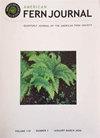Vulnerability Segmentation in Ferns and Its Implication on Their Survival During Drought
IF 0.9
4区 生物学
Q4 PLANT SCIENCES
引用次数: 0
Abstract
Abstract. Climate change is expected to increase temperature and temporal precipitation variability leading to higher evapotranspiration and more frequent and severe droughts. While advancements are being made in our understanding of how plants will respond to these changes, gaps remain in our knowledge of species-specific drought response. This is especially true among herbaceous plant communities, including ferns and other seed-free vascular plants. Previous hydraulic work on ferns has almost exclusively concentrated on the leaves, with very little information on the rhizome, which is surprising given that the rhizome is the long-lived perennial organ (making it more costly and important in species survival). Only recently have rhizome hydraulics been explored in the context of drought stress. Similar to observations in many woody trees, fern leaves tend to desiccate and hydraulically disconnect before the perennial stem experiences significant levels of drought-induced embolism, suggesting strong vulnerability segmentation. These findings have significant implications for fern survival during drought. In this review we expand on these observations, integrating information from previous work on plant hydraulics and ecophysiology, to understand the implications of vulnerability segmentation on the response of ferns to future climate change.蕨类植物的脆弱性分割及其对干旱生存的影响
摘要气候变化预计将增加温度和时间降水的可变性,导致更高的蒸散量和更频繁、更严重的干旱。尽管我们对植物如何应对这些变化的理解正在取得进展,但我们对物种特异性干旱反应的认识仍存在差距。草本植物群落尤其如此,包括蕨类植物和其他无籽维管植物。以前对蕨类植物的水力研究几乎完全集中在叶子上,对根茎的信息很少,这令人惊讶,因为根茎是长寿的多年生器官(这使得它在物种生存中更加昂贵和重要)。直到最近才在干旱胁迫的背景下对根茎水力学进行了探索。与许多木本树木的观察结果类似,蕨类植物的叶子在多年生茎经历显著程度的干旱诱导栓塞之前往往会干燥并水力断开,这表明其脆弱性很强。这些发现对蕨类植物在干旱期间的生存具有重要意义。在这篇综述中,我们对这些观察结果进行了扩展,整合了先前植物水力学和生态生理学工作的信息,以了解脆弱性分割对蕨类植物应对未来气候变化的影响。
本文章由计算机程序翻译,如有差异,请以英文原文为准。
求助全文
约1分钟内获得全文
求助全文
来源期刊

American Fern Journal
生物-植物科学
CiteScore
1.20
自引率
0.00%
发文量
28
审稿时长
6 months
期刊介绍:
The American Fern Journal is a peer-reviewed journal focused on the biology of ferns and lycophytes.
 求助内容:
求助内容: 应助结果提醒方式:
应助结果提醒方式:


